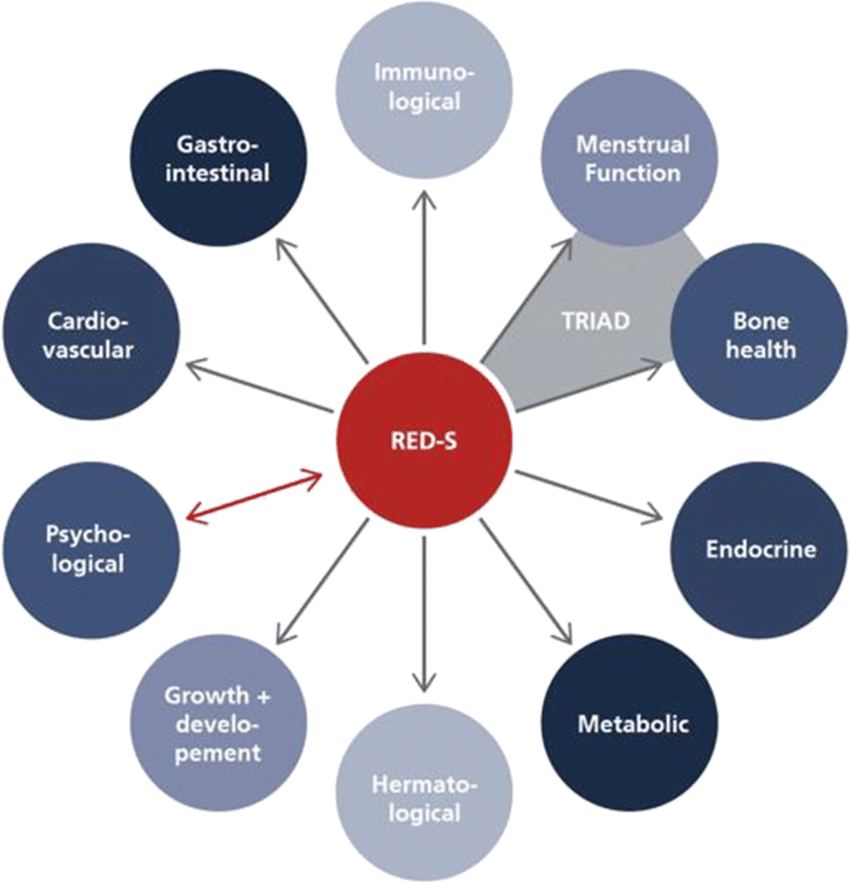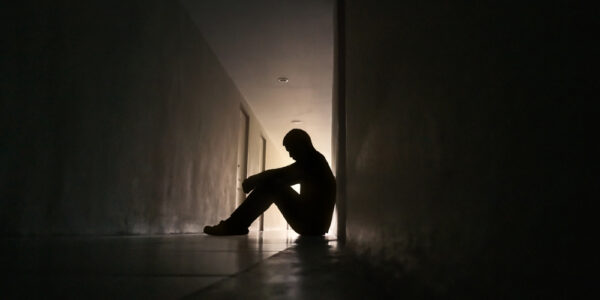LISTEN TO THIS ARTICLE:
Recognition and awareness of the unique needs of an athlete’s mental health is critical. One relatively unknown condition that many athletes of all ages, genders, and levels face is called Relative Energy Deficiency in Sport, also known as RED-S. It refers to a syndrome caused by low energy availability (LEA) in athletes and other active individuals. RED-S occurs when a person’s nutritional intake does not support the energy needed for maintaining healthy daily functioning in combination with the energy exerted during exercise or sporting activities.
Without the proper fuel to meet the high energy demands, an energy imbalance occurs. This leads to declining performance, poor physical health, and negative mental health effects. While athletes competing in any sport are at risk of developing RED-S, it occurs at even higher rates in sports where the body is a central focus for evaluation and performance such as dance, figure skating, gymnastics, and running.
RED-S occurs when a person’s nutritional intake does not support the energy needed for maintaining healthy daily functioning in combination with the energy exerted during exercise or sporting activities.
Mental health in sports is receiving more wide-spread media attention due to high profile athletes who are speaking out. Simone Biles, an elite gymnast, withdrew from events during the 2020 Tokyo Olympic games while experiencing a phenomenon called the twisties. She has since become a vocal mental health advocate. Mary Cain, a long-distance runner, was the fastest high schooler in America before turning professional. She experienced a toxic culture that led to an eating disorder and other negative mental health effects. In 2019, she shared her story via a bold opinion editorial in the New York Times. Most recently, two players on the United States Women’s National Soccer Team (USWNT) dedicated this year’s World Cup tournament to former Stanford University teammate, Katie Meyer, who died by suicide last year. These athletes are creating safe spaces for important conversations on prioritizing mental health in sport above competition outcomes.
History of RED-S
In the 1990s, researchers developed the term Female Athlete Triad as more studies focused on female athlete health in sports. The condition originally referred to a “triad,” or three main symptoms caused by insufficient nutrition to fuel athletic activities that impacted female athletes. The three symptoms are amenorrhea (a loss of a girl’s period), low energy availability, and osteoporosis (low bone mineral density). In 2014, the International Olympic Committee expanded upon the diagnostic criteria for the Female Athlete Triad. They wanted to establish a more encompassing term that represents the broader consequences of insufficient energy availability on a person’s athletic performance and wellbeing.
The term RED-S was created to reflect the many other negative health effects that can occur when a person does not eat enough nutritious foods to meet the energy demands of their sport. The original diagnosis excluded a large population of athletes who suffered from low energy due to unmet nutritional needs. RED-S is representative of all genders and ages. It can affect anyone who is impacted by poor health and declining athletic performance due to underfueling.
Effects of RED-S
RED-S can negatively affect several systems of the body. These include the reproductive, musculoskeletal, immune, metabolic, gastrointestinal, endocrine, and cardiovascular systems. The graphic below highlights all of the body’s systems that are impacted by underfueling. It is also representative of how acknowledging the Female Athlete Triad as a subset to RED-S is important as it now addresses all of the potential effects of underfueling in sport rather than solely focusing on a narrow set of symptoms that affect a specific population.

Symptoms of RED-S
There are many significant symptoms caused by inadequate nutrition intake. These include increased risk of injury, impaired judgment, decreased coordination, decreased concentration, and decreased muscle strength. If left untreated, RED-S causes issues such as menstrual dysfunction, stress fractures, infections and colds, low heart rate, dizziness, and a slower metabolism.

Mental Health and RED-S
RED-S can impact psychological health, resulting in moodiness, irritability, depression, and anxiety. Depression may make a person have little interest in food or physical activity, which can contribute to underfueling and negative performance. Anxiety can cause nausea and an upset stomach, which may also interfere with healthy eating habits. A recent review of current research literature suggests that athletes with low energy availability are 2.4 times more likely to develop a psychological disorder than those with adequate energy intake.
Causes of RED-S
There are many reasons why an athlete may develop RED-S. One major contributing factor is disordered eating patterns caused by unhealthy athletic environments. External pressure from coaches, parents, and peers to maintain a perceived ideal body for a specific sport can lead to a negative relationship with food. Several sports have a culture of body shaming, especially when wearing form-fitting attire is an expectation for participation. Gymnasts and dancers are often subject to intense scrutiny during performances. Other sports, including lightweight rowing and wrestling, have strict limits placed on maximum body weight for competition. Regular weigh-ins are a part of the rules for being able to participate.
External pressure from coaches, parents, and peers to maintain a perceived ideal body for a specific sport can lead to a negative relationship with food.
Other athletes believe that weight loss will lead to better outcomes. In some sports, like running, the initial stages of losing weight may slightly increase performance. The athlete then attributes the weight loss to success. They continue to underfuel themselves leading to low energy availability and eventually RED-S. Despite the significant drop in performance after this initial period, the athlete will continue to try and maintain a certain body weight or attempt to lose even more weight. Finally, it may be a lack of education on the part of the athlete about RED-S. Some athletes believe they are fueling adequately even though they are not meeting their body’s nutritional needs. Because of this, they never achieve their full potential.
Treatment
Low energy availability is something all athletes face after an intense workout or game. However, with proper rest and nutrition, it is possible to continue training in a healthy way. It is the cumulative effects of training and underfueling that are problematic. To assess an athlete’s risk level for developing this syndrome, physicians use evidence-based assessment tools such as the RED-S Clinical Assessment Tool (CAT). The RED-S CAT is composed of a red light, yellow light, and green light diagnostic scale. It includes a “Return to Play Model” based on where the athlete scores on the assessment tool.

If an athlete is at risk, they should see the appropriate healthcare professionals in order to develop a treatment plan. It requires a dedicated team to treat RED-S:
- Primary Care Provider (PCP) – can assess risk level, order blood work, monitor lab levels, and refer athletes to specific medical specialists depending on which system of the body has been affected.
- Sports Dietitian – can help an athlete identify what and when to eat based on their workout regimen in order to prevent energy imbalance.
- Sports Psychologist or Psychiatrist – can help treat eating disorders, depression, and anxiety.
- Exercise Physiologist – can analyze a person’s medical history and help adjust training schedules to better support the athlete’s individual needs.
Awareness, prevention, recognition, and multidisciplinary treatment is key to decreasing the number of athletes who have RED-S. Mental health in sports is just as important as physical health. It is imperative that coaches and healthcare professionals treat the whole person, focusing on both mind and body.

 Learn
Learn Read Stories
Read Stories Get News
Get News Find Help
Find Help

 Share
Share
 Share
Share
 Share
Share
 Share
Share



